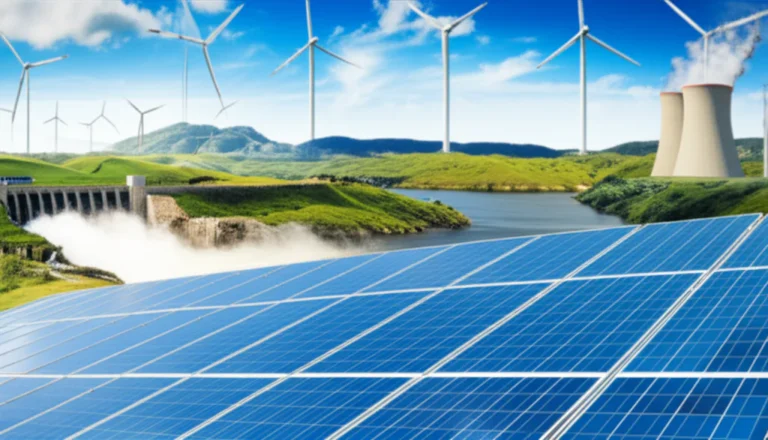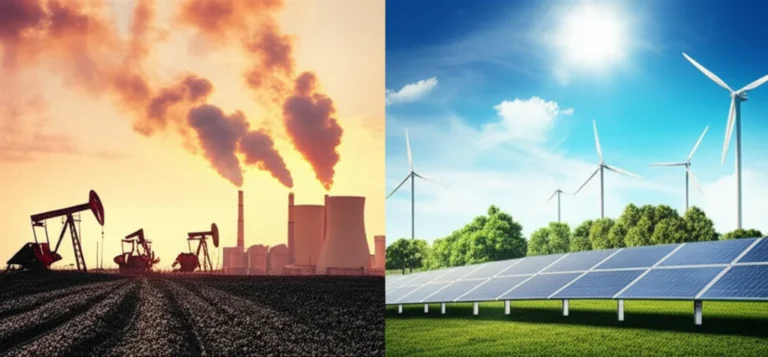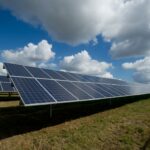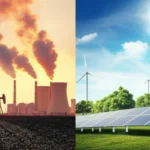Support our educational content for free when you purchase through links on our site. Learn more
🌿 7 Must-Know Renewable Energy Facts for Students (2025)
Imagine powering your school computer lab with sunlight or wind—sounds like science fiction? Well, it’s happening right now! Renewable energy is no longer just a future dream; it’s a vibrant, growing reality transforming how we live, learn, and protect our planet. Whether you’re a student curious about how solar panels work or dreaming of a career in green tech, this guide is your ultimate energy toolkit. We’ll unravel the seven main types of renewable energy, explore their benefits and challenges, and show you how YOU can be part of the green revolution. Ready to spark your curiosity and power up your knowledge? Let’s dive in!
Did you know that in 2023, renewable energy accounted for nearly 10% of the U.S. energy mix, with solar and wind leading the charge? But here’s the kicker: despite this progress, many students still wonder how these technologies work and why they matter. Stick around as we break it all down with fun facts, real stories, and practical tips to help you become a renewable energy whiz.
Key Takeaways
- Renewable energy sources like solar, wind, and hydropower are clean, sustainable, and crucial for fighting climate change.
- Each type of renewable energy has unique strengths and challenges—knowing these helps us build smarter, greener energy systems.
- Students can actively contribute by learning, advocating, and even launching local green projects.
- The renewable energy sector offers exciting career opportunities in engineering, policy, science, and more.
- Innovations like battery storage and green hydrogen are shaping the future of clean energy.
👉 Shop Renewable Energy Essentials:
- Tesla Solar Roof: Amazon | Tesla Official Website
- Residential Wind Turbines: Amazon | Siemens Gamesa Official Website
- Tesla Powerwall Battery Storage: Amazon | Tesla Official Website
Ready to become a green energy guru? Keep reading to unlock the secrets of renewable energy!
Table of Contents
- ⚡️ Quick Tips and Facts: Your Green Energy Cheat Sheet!
- 🕰️ Unearthing the Roots: A Brief History of Renewable Energy’s Journey
- 💡 What Exactly IS Renewable Energy? Demystifying the Green Powerhouse
- 🌍 Why Go Green? The Irresistible Benefits of Harnessing Nature’s Power
- 🌱 The Big Seven: Exploring the Main Types of Renewable Energy Sources
- 1. Solar Power: Catching Rays for a Brighter Future ☀️
- 2. Wind Power: Harnessing the Invisible Giant 🌬️
- 3. Hydropower: The Mighty Flow of Clean Electricity 🌊
- 4. Geothermal Energy: Tapping into Earth’s Inner Heat 🔥
- 5. Biomass Energy: Nature’s Recyclers at Work 🌱
- 6. Ocean Energy: Waves, Tides, and Thermal Gradients 🐠
- 7. Hydrogen Fuel Cells: The Future’s Clean Combustion 💧
- 🆚 Renewable vs. Non-Renewable: A Head-to-Head Showdown for Our Planet’s Future
- 🌐 The Global Green Shift: How Renewable Energy is Transforming Our World
- 🚧 Challenges on the Horizon: Overcoming Obstacles to a Fully Renewable Future
- 🚀 Innovations & Emerging Technologies: What’s Next in Green Energy?
- 🦸 Your Role in the Green Revolution: How Students Can Make a Difference
- 👷♀️ Green Careers: Building a Future in Renewable Energy
- ✅ Conclusion: Powering Tomorrow, Today!
- 🔗 Recommended Links: Dive Deeper into Green Energy
- ❓ FAQ: Your Burning Questions About Renewable Energy Answered
- 📚 Reference Links: Our Sources for Green Wisdom
⚡️ Quick Tips and Facts: Your Green Energy Cheat Sheet!
Welcome to the electrifying world of renewable energy! 🌿 Before we dive deep, here’s a quick cheat sheet to get your green gears turning:
- Renewable energy comes from sources that naturally replenish—think sun, wind, water, and even Earth’s heat.
- In 2023, about 9% of U.S. energy consumption was renewable, with solar and wind leading the charge.
- Renewable sources help slash greenhouse gas emissions, making our planet healthier and happier.
- The big players: solar, wind, hydropower, geothermal, biomass, ocean energy, and hydrogen fuel cells.
- Challenges? Yep, like storage, intermittency, and upfront costs—but innovation is charging ahead!
Want to know how you can shrink your carbon footprint? Check out our detailed guide on Uncover Your Carbon Footprint: 10 Essential Steps to Reduce It 🌍. This is just the start—let’s power up your knowledge!
🕰️ Unearthing the Roots: A Brief History of Renewable Energy’s Journey

Renewable energy isn’t just a modern buzzword—it’s been part of human history for centuries!
From Wood Fires to Windmills: A Timeline
- Pre-1800s: Wood was king. Our ancestors burned wood for heat and cooking, making it the primary energy source.
- Late 1800s: Fossil fuels like coal and petroleum took center stage, powering the Industrial Revolution.
- Early 1900s: Hydropower dams began sprouting, harnessing rivers for electricity.
- 1990s onward: A green renaissance! Solar panels, wind turbines, biofuels, and geothermal tech surged forward.
Why Does This History Matter?
Understanding this evolution helps us appreciate how far we’ve come—and why renewable energy is crucial for a sustainable future. As the U.S. Energy Information Administration notes, renewable energy production hit record highs in 2022, signaling a promising shift.
💡 What Exactly IS Renewable Energy? Demystifying the Green Powerhouse
At its core, renewable energy is energy derived from sources that naturally replenish on a human timescale. Unlike fossil fuels, which take millions of years to form, renewables are virtually inexhaustible.
The Science Behind It
- Solar energy captures sunlight using photovoltaic cells or mirrors.
- Wind energy harnesses air currents to spin turbines.
- Hydropower uses flowing water to generate electricity.
- Geothermal energy taps into Earth’s internal heat.
- Biomass converts organic material into fuel or electricity.
- Ocean energy exploits tides and waves.
- Hydrogen fuel cells generate power through chemical reactions with hydrogen.
These sources produce clean energy, meaning they emit little to no greenhouse gases or pollutants, making them champions of environmental health.
🌍 Why Go Green? The Irresistible Benefits of Harnessing Nature’s Power
Why should you care about renewable energy? Because it’s a win-win for you and the planet!
Top Benefits:
- Cleaner air and water: Less pollution means fewer respiratory illnesses and healthier ecosystems.
- Climate change mitigation: Renewables reduce carbon emissions, helping slow global warming.
- Energy independence: Using local resources reduces reliance on imported fuels.
- Job creation: The green economy is booming, offering careers in tech, engineering, and more.
- Sustainability: Unlike fossil fuels, renewables won’t run out anytime soon.
At Gone Greenish™, we’ve seen firsthand how switching to renewables can boost community health and economic resilience.
🌱 The Big Seven: Exploring the Main Types of Renewable Energy Sources
1. Solar Power: Catching Rays for a Brighter Future ☀️
Solar energy is the superstar of renewables, converting sunlight into electricity or heat.
How It Works
- Photovoltaic (PV) cells turn sunlight directly into electricity.
- Solar thermal systems use mirrors or panels to heat water or air.
Pros & Cons
| Aspect | Rating (1-10) | Notes |
|---|---|---|
| Efficiency | 7 | PV cells last ~20 years; efficiency varies with sunlight. |
| Cost | 6 | Installation can be pricey but dropping fast. |
| Environmental Impact | 9 | Clean, no emissions during operation. |
| Reliability | 5 | Dependent on weather and daylight hours. |
Real-World Example
Tesla’s Solar Roof integrates PV cells into roof tiles, blending aesthetics with function. Customers rave about the sleek design and energy savings, although upfront costs remain a hurdle.
👉 CHECK PRICE on:
2. Wind Power: Harnessing the Invisible Giant 🌬️
Wind turbines convert kinetic energy from air currents into electricity.
How It Works
- Blades spin when wind blows, turning a generator.
- Wind farms cluster turbines for large-scale power production.
Pros & Cons
| Aspect | Rating (1-10) | Notes |
|---|---|---|
| Efficiency | 8 | Wind farms can generate massive amounts of power. |
| Cost | 7 | Installation and maintenance costs moderate. |
| Environmental Impact | 7 | No emissions, but concerns about bird/bat mortality. |
| Reliability | 5 | Wind is variable; offshore farms often more consistent. |
Anecdote
A friend of ours in Texas installed a small wind turbine at home. While it doesn’t power the entire house, it significantly cuts their electric bill and feels like a personal victory for sustainability.
👉 Shop wind turbines on:
3. Hydropower: The Mighty Flow of Clean Electricity 🌊
Hydropower uses flowing water to spin turbines and generate electricity.
How It Works
- Dams create reservoirs; water released spins turbines.
- Run-of-river systems use natural flow without large dams.
Pros & Cons
| Aspect | Rating (1-10) | Notes |
|---|---|---|
| Efficiency | 9 | One of the most efficient renewable sources. |
| Cost | 8 | High initial cost, low operating cost. |
| Environmental Impact | 5 | Dams can disrupt ecosystems and displace communities. |
| Reliability | 8 | Generally reliable, but droughts can reduce output. |
Fun Fact
The Hoover Dam powers over 1 million homes and is a marvel of engineering and green energy.
4. Geothermal Energy: Tapping into Earth’s Inner Heat 🔥
Geothermal energy exploits heat from beneath Earth’s surface for power and heating.
How It Works
- Wells tap hot water or steam underground to drive turbines.
- Geothermal heat pumps circulate water through underground pipes to heat/cool buildings.
Pros & Cons
| Aspect | Rating (1-10) | Notes |
|---|---|---|
| Efficiency | 8 | Provides consistent base-load power. |
| Cost | 6 | High upfront drilling costs; low maintenance. |
| Environmental Impact | 8 | Low emissions; some water use concerns. |
| Reliability | 9 | Very reliable and stable energy source. |
Real-World Example
Iceland heats nearly 90% of its homes with geothermal energy—talk about living the green dream!
5. Biomass Energy: Nature’s Recyclers at Work 🌱
Biomass energy uses organic materials like wood, manure, and crops to produce heat or electricity.
How It Works
- Biomass is burned directly or converted into biofuels.
- Biofuels can power vehicles with fewer emissions than gasoline.
Pros & Cons
| Aspect | Rating (1-10) | Notes |
|---|---|---|
| Efficiency | 6 | Energy density lower than fossil fuels. |
| Cost | 7 | Often uses waste products, reducing costs. |
| Environmental Impact | 6 | Can be carbon-neutral if managed sustainably. |
| Reliability | 7 | Can be stored and used on demand. |
Cautionary Tale
Growing biofuel crops requires land and pesticides, which can impact ecosystems if not managed carefully. Sustainability is key!
6. Ocean Energy: Waves, Tides, and Thermal Gradients 🐠
Ocean energy captures power from tides, waves, and temperature differences in seawater.
How It Works
- Tidal turbines spin with ocean tides.
- Wave energy converters float on the surface, capturing wave motion.
- Ocean Thermal Energy Conversion (OTEC) exploits temperature differences.
Pros & Cons
| Aspect | Rating (1-10) | Notes |
|---|---|---|
| Efficiency | 5 | Still emerging technology; potential huge. |
| Cost | 4 | Expensive and complex to install. |
| Environmental Impact | 7 | Minimal emissions; potential marine impact. |
| Reliability | 7 | Tides are predictable; waves less so. |
7. Hydrogen Fuel Cells: The Future’s Clean Combustion 💧
Hydrogen fuel cells generate electricity by combining hydrogen and oxygen, emitting only water vapor.
How It Works
- Hydrogen gas is fed into the cell, producing electricity and water.
- Can power vehicles, buildings, and even spacecraft!
Pros & Cons
| Aspect | Rating (1-10) | Notes |
|---|---|---|
| Efficiency | 7 | High energy density; clean emissions. |
| Cost | 5 | Expensive production and infrastructure. |
| Environmental Impact | 9 | Zero emissions at point of use. |
| Reliability | 8 | Can be stored and used on demand. |
🆚 Renewable vs. Non-Renewable: A Head-to-Head Showdown for Our Planet’s Future
Let’s pit the green champs against the old guard—renewable vs. non-renewable energy.
| Feature | Renewable Energy ✅ | Non-Renewable Energy ❌ |
|---|---|---|
| Source | Naturally replenished (sun, wind, water, etc.) | Finite (coal, oil, natural gas) |
| Environmental Impact | Low emissions, cleaner air and water | High emissions, pollution, climate change driver |
| Cost Over Time | Decreasing installation costs, low operating costs | Variable costs, often subsidized fossil fuels |
| Reliability | Intermittent (sunlight, wind) but improving storage | Generally stable but depleting resources |
| Job Creation | Growing green jobs in tech and manufacturing | Declining jobs in coal and oil sectors |
The future is clear: to protect our planet and health, renewables must take center stage.
🌐 The Global Green Shift: How Renewable Energy is Transforming Our World
Renewable energy isn’t just a U.S. story—it’s a global revolution!
Leading the Charge
- China leads in solar and wind installations.
- The European Union pushes aggressive renewable targets.
- The United States is rapidly expanding wind and solar capacity.
- Brazil excels in biofuels and hydropower.
- Canada leverages vast hydropower resources.
Impact on Climate and Economy
Renewables are cutting global carbon emissions and creating millions of jobs worldwide. According to the International Renewable Energy Agency (IRENA), renewable energy employment surpassed 13 million jobs globally in 2023.
🚧 Challenges on the Horizon: Overcoming Obstacles to a Fully Renewable Future
No journey is without bumps! Here’s what’s holding renewables back—and how we’re tackling it:
Key Challenges
- Intermittency: Sun doesn’t always shine; wind doesn’t always blow.
- Storage: Batteries and other tech are improving but still costly.
- Infrastructure: Grid upgrades needed to handle distributed energy.
- Environmental Concerns: Wildlife impacts, land use, and resource extraction.
- Economic Barriers: Upfront costs and policy hurdles.
Solutions in Motion
- Battery innovations: Tesla’s Powerwall and other storage tech are game-changers.
- Smart grids: Digital tech to balance supply and demand.
- Policy incentives: Tax credits and subsidies for renewables.
- Community projects: Local solar co-ops and wind farms empower citizens.
🚀 Innovations and Emerging Technologies: What’s Next in Green Energy?
The green revolution is turbocharged by innovation! Here’s what’s on the horizon:
- Perovskite solar cells: Cheaper, more efficient solar tech.
- Floating offshore wind farms: Harnessing stronger, steadier winds at sea.
- Green hydrogen: Produced from renewables, powering everything from trucks to factories.
- Energy blockchain: Decentralizing energy trading for efficiency and fairness.
- Artificial intelligence: Optimizing energy production and consumption.
At Gone Greenish™, we’re buzzing with excitement about these breakthroughs—they’re the secret sauce for a sustainable tomorrow!
🦸 Your Role in the Green Revolution: How Students Can Make a Difference
Hey students, you’re not just future leaders—you’re green heroes in training! Here’s how you can jump in:
Simple Steps to Start
- Learn and share: Knowledge is power—spread the word about renewable energy.
- Reduce your carbon footprint: Check out our guide on carbon footprint reduction.
- Get involved: Join or start eco-clubs, participate in clean energy projects.
- Advocate: Talk to local officials about renewable energy policies.
- Innovate: Experiment with solar kits, wind turbines, or biofuel projects.
Inspiring Story
One of our team members started a school solar panel project that now powers the computer lab—proof that small actions spark big change!
👷♀️ Green Careers: Building a Future in Renewable Energy
Dreaming of a career that saves the planet? Renewable energy is a booming field with diverse opportunities:
| Career Path | What You Do | Skills Needed | Growth Outlook |
|---|---|---|---|
| Renewable Energy Engineer | Design and improve renewable tech like turbines and solar panels | Engineering, problem-solving | High demand |
| Environmental Scientist | Study impacts and develop sustainable solutions | Science, data analysis | Growing rapidly |
| Energy Policy Analyst | Shape laws and incentives for green energy | Policy, communication | Increasing importance |
| Solar Installer | Install and maintain solar power systems | Technical skills, physical work | Strong growth |
| Sustainability Consultant | Advise businesses on reducing environmental impact | Business, environmental science | Expanding field |
Check out our Eco-Conscious Brands and Green Home categories for inspiration on companies leading the way.
Ready to keep powering your green journey? Stay tuned for our conclusion, recommended links, FAQs, and references to keep your renewable energy knowledge shining bright!
✅ Conclusion: Powering Tomorrow, Today!

Wow, what a journey through the vibrant world of renewable energy! From the sun’s radiant rays to the deep heat of the Earth, we’ve uncovered the powerful potential and complex challenges of going green. Renewable energy is not just a buzzword—it’s a lifeline for our planet’s health and our own well-being.
Here’s the bottom line:
- Renewables offer cleaner air, reduced greenhouse gases, and sustainable energy security.
- While challenges like intermittency and infrastructure remain, innovation and community action are lighting the way forward.
- Students and individuals have a vital role to play—whether by learning, advocating, or even launching solar projects at school.
- The green economy is booming, with exciting career paths waiting for passionate changemakers like you!
At Gone Greenish™, we wholeheartedly recommend embracing renewable energy—not just as a concept, but as a lifestyle and future career path. The planet needs your energy, your ideas, and your passion. So, what are you waiting for? Let’s power up and make a difference!
🔗 Recommended Links: Dive Deeper into Green Energy
👉 Shop Renewable Energy Products:
- Tesla Solar Roof: Amazon | Tesla Official Website
- Residential Wind Turbines: Amazon | Siemens Gamesa Official Website
- Tesla Powerwall Battery Storage: Amazon | Tesla Official Website
Recommended Books for Students and Enthusiasts:
- Renewable Energy Made Easy by David Darst — A beginner-friendly guide to understanding and using renewable energy. Amazon Link
- Energy Island: How One Community Harnessed the Wind and Changed Their World by Allan Drummond — An inspiring true story of a Danish island’s renewable revolution. Amazon Link
- The Boy Who Harnessed the Wind by William Kamkwamba — A remarkable tale of innovation and determination using renewable energy. Amazon Link
❓ FAQ: Your Burning Questions About Renewable Energy Answered

What are the benefits of renewable energy for the environment and human health?
Renewable energy reduces reliance on fossil fuels, which emit harmful pollutants like carbon dioxide, sulfur dioxide, and particulate matter. This leads to cleaner air and water, reducing respiratory diseases, heart conditions, and environmental degradation. By cutting greenhouse gas emissions, renewables also combat climate change, which poses severe health risks worldwide.
Read more about “Is Clean Energy the Same as Renewable Energy? 7 Surprising Facts (2025) ⚡️”
How can students get involved in promoting renewable energy in their communities?
Students can start by educating themselves and others through clubs, presentations, and social media. Participating in or initiating solar panel projects, energy audits, or tree planting campaigns can make a tangible impact. Advocacy is powerful—writing to local officials or organizing awareness events helps push for greener policies. Volunteering with environmental organizations also offers hands-on experience.
What are some fun and interactive ways to teach kids about renewable energy?
Hands-on activities like building mini solar ovens, wind turbines from kits, or simple hydropower models engage kids creatively. Educational games, apps, and videos that explain energy concepts in story form make learning memorable. Field trips to local renewable energy sites or science museums can spark curiosity. Storybooks like Energy Island or The Boy Who Harnessed the Wind inspire young minds.
Read more about “⚡️ Renewable Energy Uncovered: 15 Game-Changing Facts & Innovations (2025)”
How does renewable energy contribute to a healthy planet and sustainable future?
Renewable energy sources generate power without depleting natural resources or emitting toxic pollutants. This helps maintain biodiversity, reduces carbon footprints, and protects ecosystems. Sustainable energy systems also promote economic stability by creating green jobs and reducing dependence on volatile fossil fuel markets. Together, these factors build resilience against climate change and environmental crises.
Read more about “Carbon Neutral Uncovered: 12 Essential Facts You Need to Know (2025) 🌿”
What are the different types of renewable energy sources and their advantages?
The main types include:
- Solar: Abundant and scalable, great for rooftops and remote areas.
- Wind: Efficient for large-scale power, especially offshore.
- Hydropower: Reliable and efficient but requires careful ecosystem management.
- Geothermal: Provides consistent base-load power and heating.
- Biomass: Utilizes waste materials and can be stored for on-demand use.
- Ocean Energy: Predictable tidal power with vast untapped potential.
- Hydrogen Fuel Cells: Clean and versatile, ideal for transport and storage.
Each has unique benefits and challenges, making a diverse energy mix essential.
How can individuals make a positive impact on the environment by using renewable energy?
Switching to renewable-powered utilities or installing solar panels reduces your carbon footprint. Supporting green energy providers and advocating for clean energy policies amplifies impact. Simple lifestyle changes like energy conservation, using energy-efficient appliances, and reducing waste complement renewable adoption. Every watt counts!
Read more about “Harnessing Solar Power: 10 Game-Changing Insights for 2025 🌞”
What role can renewable energy play in reducing air pollution and promoting public health?
By replacing coal, oil, and gas with renewables, we cut emissions of smog-forming pollutants and toxic chemicals. This leads to fewer asthma attacks, heart disease cases, and premature deaths. Cleaner air also benefits wildlife and ecosystems. The World Health Organization estimates that air pollution causes millions of deaths annually—renewable energy is a key solution to this crisis.
How does energy storage improve the reliability of renewable energy systems?
Energy storage technologies like lithium-ion batteries, pumped hydro, and emerging solid-state batteries store excess energy generated during sunny or windy periods. This stored energy can be dispatched when demand is high or renewable output is low, smoothing out fluctuations and ensuring a steady power supply. Tesla’s Powerwall and other home batteries are popular examples empowering consumers to manage energy better.
What are the environmental trade-offs of large-scale renewable energy projects?
While renewables reduce emissions, large projects can impact land use, wildlife habitats, and water resources. For example, hydropower dams may flood ecosystems, and wind turbines can affect bird populations. Responsible planning, environmental assessments, and technological innovations like bird-safe turbine designs help mitigate these impacts. Balancing ecological health with clean energy goals is crucial.
📚 Reference Links: Our Sources for Green Wisdom
- U.S. Energy Information Administration (EIA) – Renewable Energy Explained
- National Geographic Education – Renewable Energy Resource
- Alliant Energy Kids – What is Renewable Energy?
- International Renewable Energy Agency (IRENA) – Renewable Energy and Jobs Annual Review
- Tesla – Solar Roof | Powerwall
- Siemens Gamesa – Wind Power Solutions
For more green insights, check out our Carbon Footprint Reduction, Eco-Conscious Brands, and Green Home categories.






